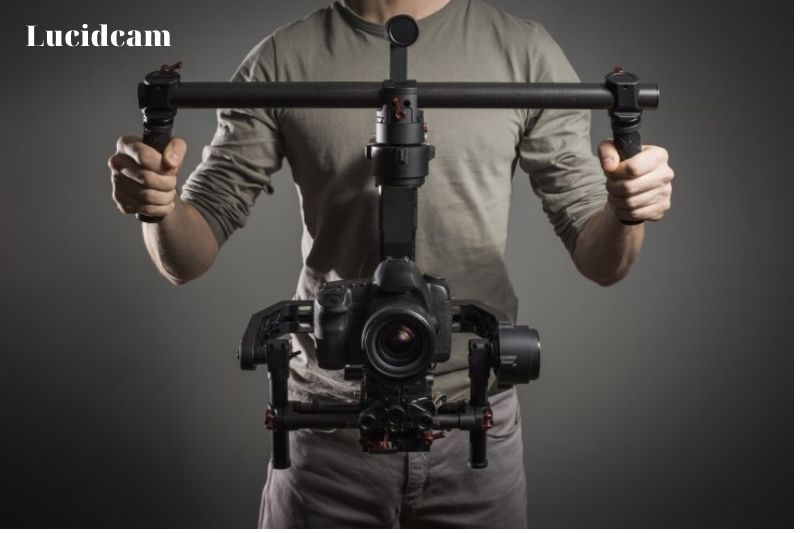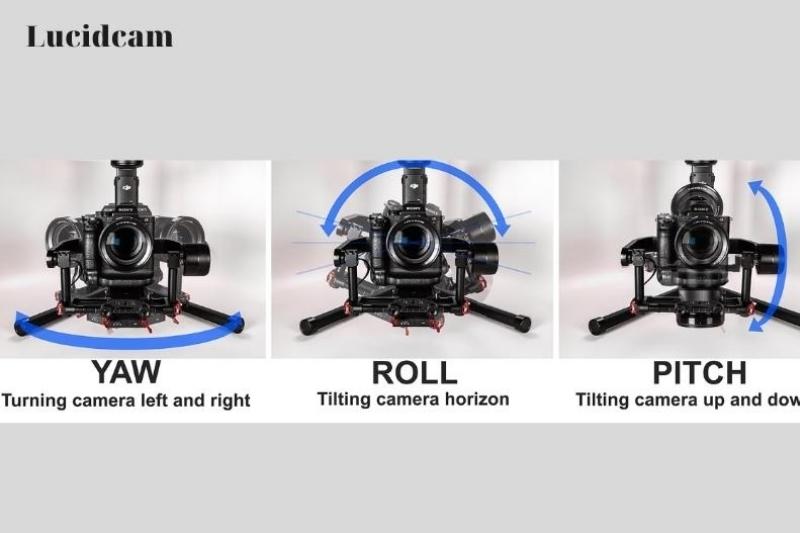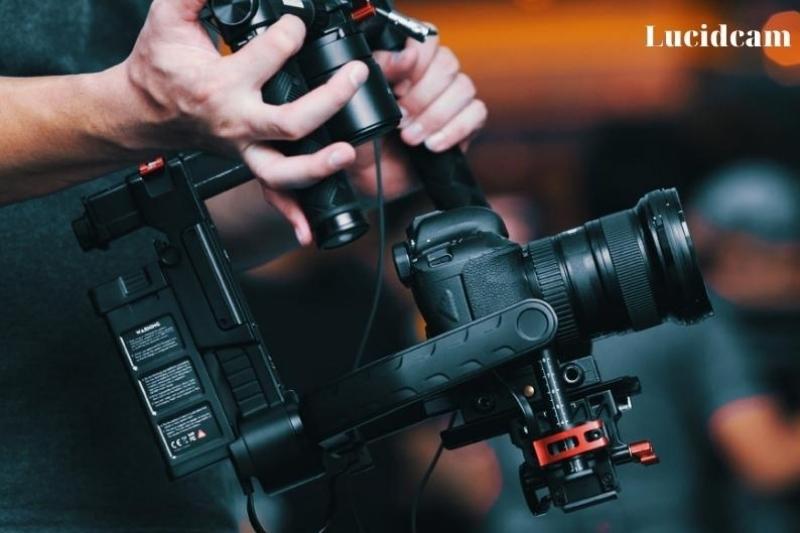We are sure that you have seen or heard about a Gimbal and have watched a video of it in action. The Gimbal is so levelheaded and smooth that you would think it has a mind or artificial intelligence. In this blog, We will be exploring the mysteries of How Does Gimbal Works? and why it is so incredible!
Table of Contents
What are Gimbals?

Image Stabilization (IS), is a technique that reduces blurred photos by moving the camera lens automatically to compensate for camera shake and vibration during photography. Two common methods for image stabilization are:
- Software electronic (Electronic Image Stabilization – EIS)
- Optic image stabilization – OIS (hardware optical)
To improve image quality, electronic image stabilization employs a sophisticated software algorithm.
Optic image stabilization (or optical image stabilization) is a hardware solution that eliminates image blur due to camera shake or jitter while shooting. It is important to know that OIS doesn’t completely eliminate camera shake, but it does partially mitigate its effects. OIS won’t operate if the device shakes too much.
Electronic stabilization has the advantage that it requires only software to operate. OIS requires additional hardware components. Both image stabilization technologies can be used simultaneously.
It is common to believe that high-resolution cameras will produce a great image. Professionals can actually see that the cameras are attached securely to something, which prevents any sudden movements and shakes. Electronic stabilizers are the latest version of such a system for manual recording. These electronic stabilizers compensate for rotation due to the integrated electric motors.
How Does a Gimbal Work?
Blurring in photos can be caused by the shifting of the optical path between a focal length lens and the center sensor.
Adjusting the optical path of an image sensor to achieve the desired result by tilting or moving the lens to neutralize or compensate for the user’s movement can be done. There are two methods.
- The lens shift method was used previously. This is where the lenses within the cameras module are able to make small shifts. It does not allow for changing the optical path.
- The second, more modern method involves moving the entire module, including the image sensor, lens, and cameras This is how photo stabilization happens.
Optic image stabilization employs a variety of sensors to determine the offset along the coordinate axes X and Y. Sensors can also detect deviation and oblique displacement. All data is used to determine how big a shift in the lens position is necessary to ensure that the optical path is aligned with the center of an image sensor.
Although electronic image stabilization can achieve a similar result to analog, it isn’t enough for professional use due to its poor image quality.
Gimbals can use either EIS or OIS to fix these issues.
Two frames are used to connect any gimbal. The cameras and the handle are held by the frame. Three hinges powered by electric motors are located between the frames. Each electric motor stops the cameras from rotating on one of the three axes. A gimbal, also known as an “axis gimbal,” is a device that prevents the cam from rotating along with one of three axes. These three axes are often referred to as:
- Pitch – Up and Down movement
- Yaw – movement from side to side
- Roll – A circular movement that is either anticlockwise or clockwise.
Gimbals can also be equipped with gyroscopes that control the rotation of the cam around these axes.
Gimbals and all the features that come with them can stabilize your cams, prevent it from shaking, and produce a smooth recording and excellent photo quality.
All this proves that the electronic stabilizer, even in its most basic form, is a highly-tech device whose capabilities can only have been used for a lot more money in the past.
How Does Gimbal Work in Camera Stabilizer?

A gimbal is an essential component of a camera stabilizer, which helps to keep the camera steady and level while shooting videos or taking photos. The working mechanism of a gimbal in a camera stabilizer is based on the principles of a gyroscope.
A typical gimbal consists of three interconnected rings, with the innermost ring supporting the camera or other equipment. The outer rings are motorized and move independently of each other to compensate for any motion or vibration, keeping the camera level and steady.
The first ring in the gimbal is responsible for supporting the camera, while the other two rings are used for stabilization. The second ring is attached to the first ring through a set of motors and gears, which allow it to move horizontally and vertically.
The third ring is attached to the second ring and can move independently in the roll axis, allowing the camera to maintain its level orientation even if the device is tilted.
The gimbal may also feature sensors and electronic components that help detect and correct any unwanted motion. These sensors can include accelerometers, which measure the acceleration of the device, and gyroscopes, which measure the angular velocity. The electronic components use this information to adjust the motorized rings and keep the camera level and steady.
Do You Need a Gimbal?

Whether or not you need a gimbal depends on your specific needs and the type of footage you want to capture. If you’re looking to capture smooth and stable video footage, especially while walking, running, or moving in any way, then a gimbal may be an essential tool for you. A gimbal can help eliminate unwanted shaking or vibrations, resulting in more professional-looking footage.
However, if you mostly shoot still images or videos from a stationary position, a gimbal may not be necessary. In these cases, a tripod or other stabilizing equipment might be sufficient to keep the camera steady.
It’s also worth noting that gimbals can be expensive, especially high-quality ones that are designed for professional-grade cameras and equipment. If you’re just starting out in photography or videography, it might be more cost-effective to invest in other gear first, such as a tripod, before moving on to a gimbal.
Ultimately, the decision of whether or not to use a gimbal comes down to your individual needs and preferences. If you’re frequently shooting footage that requires a lot of movement, or you want to take your videography or photography to the next level, then a gimbal can be an excellent investment.
However, if you’re mostly shooting still images or videos from a stationary position, you may not need a gimbal, and other types of stabilizing equipment may suffice.
Different Types of Gimbals

Different cameras can be used depending on the task and budget to shoot videos or photos. Because the cameras weigh different, the maximum load of the gimbals will vary.
Gimbals for Action Cams
These gimbals are compact and lightweight, designed for use with small action cameras like GoPro or DJI Osmo Action. They are ideal for capturing smooth and stable footage while engaging in sports or outdoor activities, where hand-held shots are necessary. Some popular models in this category include the DJI Osmo Action, FeiyuTech G6, and Zhiyun Crane M2.
Smartphone Gimbals
These gimbals are designed to work with smartphones and are becoming increasingly popular among content creators. They allow for smooth and stable footage while walking or moving, and some models even come with features like object tracking and time-lapse. Some popular smartphone gimbals include the DJI Osmo Mobile 3, Zhiyun Smooth 4, and Moza Mini-S.
Gimbals for DSLRs and Video Cameras
These gimbals are larger and more robust, designed for use with professional-grade cameras and equipment. They can handle heavier payloads and are ideal for capturing smooth and stable footage while walking or moving. Some popular models in this category include the DJI Ronin-S, Zhiyun Crane 3S, and Moza Air 2.
Wearable Gimbals
These gimbals are designed to be worn on the body, either on the chest or the head, to allow for hands-free shooting while maintaining stability. They are ideal for use in sports or outdoor activities, where hand-held shots are not practical. Some popular models in this category include the GoPro Karma Grip, FeiyuTech WG2X, and Removu S1.
Drone Gimbals
These gimbals are designed to be attached to drones, allowing for smooth and stable footage while flying. They can handle the vibration and movement of the drone, and some models even come with features like object tracking and automatic horizon leveling. Some popular drone gimbals include the DJI Zenmuse X5, Freefly Movi, and Gremsy T3.
Overall, the type of gimbal you choose will depend on the equipment you’re using, the type of footage you want to capture, and your personal preferences.
What Are Gimbal’s DrawBacks?

Brushless gimbals have their advantages and disadvantages, just like any other tool. You need to consider these when deciding if it is right for you. These are the downfalls of using a gimbal to shoot.
Power is required
Most gimbals require a power source to operate, whether it’s batteries or a direct power connection. This means you’ll need to keep spare batteries on hand or have access to a power source when shooting for extended periods. Depending on the model and the power source used, this can add weight and bulk to your gear.
Tired of using
Gimbals can be tiring to use for extended periods, especially if you’re holding a heavy camera and lens combination. It can be challenging to maintain a steady grip on the gimbal for long periods, leading to fatigue in your arms and hands.
Learning curve
Gimbals can be tricky to use, and it can take some time to learn how to operate them correctly. You’ll need to understand how to balance your camera and set up the gimbal correctly, which can be challenging for beginners. There’s also a learning curve to understanding how to adjust the settings to achieve the desired results.
Bulky
Gimbals can add bulk to your gear, especially if you’re using a larger model designed for DSLRs or video cameras. They can be challenging to carry around for extended periods, and you may need to use a separate bag or backpack to transport them.
Despite these drawbacks, many photographers and videographers still find gimbals to be a valuable tool for capturing smooth and stable footage. It’s essential to consider your specific needs and preferences when deciding whether or not to invest in a gimbal, as well as the potential drawbacks that come with using one.
Gimbal Applications

Gimbals have a wide range of applications across various industries, including filmmaking, photography, sports broadcasting, and more. Here’s an overview of some of the ways gimbals are used and the advantages they offer:
Filmmaking
Gimbals are commonly used in filmmaking to capture smooth and stable footage while walking, running, or moving. They allow filmmakers to achieve dynamic shots that would be challenging to capture with traditional hand-held cameras. Gimbals also enable filmmakers to get creative with their shots, exploring different angles and movements to tell a story visually.
Photography
Gimbals are becoming increasingly popular in photography, allowing photographers to capture stable shots while moving. They are ideal for capturing action shots or images in low light, where hand-held shots can be shaky and blurry. Gimbals also allow photographers to experiment with different angles and perspectives, resulting in more dynamic and visually interesting photos.
Sports broadcasting

Gimbals are often used in sports broadcasting to capture dynamic footage of athletes in action. They allow broadcasters to follow the action smoothly and provide viewers with a clear and stable view of the game. Gimbals are also ideal for capturing slow-motion replays and highlights, giving viewers a closer look at the action.
Industrial applications
Gimbals are used in various industrial applications, such as inspection and surveying, where stable footage is necessary. They are often used in drones to capture aerial footage for surveying and mapping applications. Gimbals can also be used in construction and infrastructure inspection to provide a stable view of hard-to-reach areas.
The advantages of using a gimbal for different applications include the following:
- Stability: Gimbals provide stable footage, even while walking or moving, resulting in smoother and more professional-looking shots.
- Creative flexibility: Gimbals allow for more creative shots, exploring different angles and movements that would be difficult to achieve with traditional hand-held cameras.
- Time-saving: Gimbals can save time on set or during a shoot, allowing for faster setup and more efficient filming.
- Improved quality: Gimbals can help improve the overall quality of the footage, resulting in clearer, sharper, and more visually pleasing shots.
Overall, gimbals offer numerous advantages across various industries, providing stable footage, creative flexibility, and improved quality, making them a valuable tool for content creators, broadcasters, and industrial applications.
Buying Guide

When it comes to purchasing a gimbal, there are several factors to consider to ensure you get the best possible product for your needs. Here are some of the key features to look for when buying a gimbal:
- Capacity for weight: The weight capacity of a gimbal is crucial to ensure it can support your camera and lens combination. Be sure to check the maximum weight capacity of the gimbal you’re considering to ensure it can handle your gear.
- Adjustments that are not made with tools: A gimbal that allows for adjustments without the use of tools can be a significant advantage. It enables you to make quick adjustments on the fly, without having to stop and take time to make manual adjustments.
- 32-bit controller: A 32-bit controller can help ensure smooth and precise movements, resulting in stable footage. It allows for faster processing speeds and more accurate control of the gimbal’s movements.
- Camera plate Quick-Release: A quick-release camera plate can be a significant time saver, allowing you to attach and detach your camera quickly and easily. It also ensures a secure attachment, preventing your camera from accidentally falling off the gimbal.
- Batteries: The battery life and type of batteries required for the gimbal are important considerations. Be sure to check the battery life of the gimbal you’re considering, as well as the type of batteries required. Some gimbals use proprietary batteries, while others use standard rechargeable batteries that may be more convenient and easier to replace.
Other features to consider when purchasing a gimbal include the size and weight of the gimbal, the type of handle and grip, and the types of accessories and mounting options available. It’s essential to consider your specific needs and preferences when choosing a gimbal, as well as your budget, to ensure you get the best possible product for your needs
Other Things You Need to Know About Gimbals

- Gimbals are easier to learn than counterweighted stabilizers.
- Gimbals are classified according to the number of axes they have. You can have gimbals with 2 axis, 3 axis, or 4 axis gimbals.
- Two motors and two rings are used in 2-axis gimbals. This means that the camera can be moved in a specific direction by rolling or tilting the camera holder. However, the camera will still follow if it is moved to the left to right.
- Three motors and three rings make up a 3-axes gimbal. The stabilizer is capable of maintaining a stable position in roll and tilt shifts. It can also be panned or moved sideways.
- 3-axis gimbals can be converted to 2-axes by locking the third. The versatility of 3-axis gimbals is evident.
- Gimbals can have either a servo motor or a brushless motor. Although servo motors are cheaper and lighter, their weight-load capacity is very limited. Brushless gimbals offer professional results and can handle heavier cameras.
- Gimbals need the power to function. You should always have extra batteries in case you need them.
You can refer to some gimbals for your devices here if you want to buy one:
FAQs
1. What’s the difference between a stabilizer and a gimbal?
Complexity – Gimbals have more moving parts and require a charger, battery, etc. The stabilizer is easier to use but still requires ‘balancing’ both
2. Is a Gimbal considered a Selfie Stick?
Share All sharing options: DJI’s smartphone cam gimbal now and a selfie stick. DJI has just released the DJI Osmo Mobile 5 phone gimbal. It includes a telescoping selfie stick (okay, there’s an extension rod) built into the handle. This year, the Gimbal is smaller and lighter.
